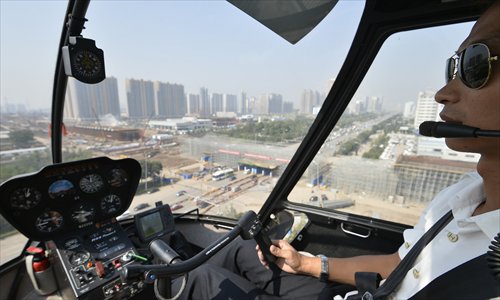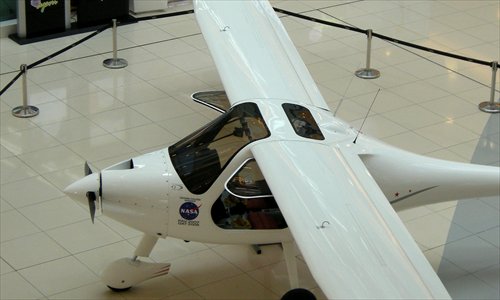HOME >> CHINA
Dreams of private planes
Source:Xinhua-Global Times Published: 2014-7-16 19:58:01
Personal pilot licensing urged as aviation skills shortage looms

A pilot flies a private plane in Taiyuan, Shanxi Province for his customers. Photo: CFP

An aeroplane is displayed in a shopping mall in Beijing to attract buyers. Photo: CFP
Thin and bespectacled, Xiao Zixuan, 17, dreams of flying a helicopter.
From July 3 to 6, the boy from Shenzhen, Guangdong Province, visited an international flight training exhibition and he remains convinced that his dream is near at hand. He foresees a successful career as a general aviation pilot.
General aviation refers to more or less all civil aviation operations other than scheduled passenger services and charters. General aviation includes flight schools, agricultural use, manufacture and maintenance of aircraft, stunt flying and air shows. The majority of the world's air traffic falls into this category, but it is seriously underdeveloped in China.
Lack of human resources is widely considered the biggest problem for the development of the general aviation sector. The shortage of pilots is the most obvious and urgent of many such problems.
More pilots needed
"People keep asking me how many pilots China needs." Chen Guangcheng, the head of pilot certification with the Civil Aviation Administration of China (CAAC), said.
"Our projection is that 20 years from now, aviation in China will be much the same as that in the US today. If that's the case, we'll need 80,000 more airline pilots, and 400,000 to 500,000 general aviation pilots."
Martin Robinson, a senior vice president of the International Aircraft Owners and Pilots Association, thinks the number could be even bigger.
China had around 35,000 certificated pilots at the end of 2013, the majority of whom work for airlines. The US has nearly 600,000 pilots in service and only a quarter of them are airline pilots. The others are student pilots, sports pilots, recreational pilots, private pilots or other commercial pilots.
There are less than 2,000 private flying license holders in China, according to the CAAC. The figure for the US is 200,000.
These half a million new pilots, Chen believes, should include both professionals and people who simply fly for fun and interest rather than occupational reasons. The CAAC supports and encourages ordinary people pursuing their flying dreams.
"New administrative rules for pilots are expected soon," Chen said. "We will bring in a new category of sports licenses and make it easier than ever for amateurs to fly."
"It's like 20 years ago when Chinese people started to learn to drive. They did not drive for a living but for their own convenience or interest," Chen explained. "Their current demands for flying need to be answered quickly by flight schools."
The exhibition hosted by China's Aircraft Owners and Pilots Association (AOPA), was attended by over half of China's 40-odd flight schools exhibitors, optimistic about prospects of China's flight training industry, an optimism shared by overseas counterparts such as the Sierra Academy of Aeronautics from the US and Antipodean Aviation of Australia.
Boost to flight training
China had its first private aviation club launched on Monday, which is set to cover all aspects of the industry, such as private license training, flying activities and aerial advertising, the Economic Daily reported. The Tianjin-based club is based has trained around 60 pilots since its trial operation since November 2013.
The AVIClub, which operates under China's State-owned Aviation Industry Corporation (AVIC), received many inquiries about its private license program at the exhibition, according to Gao Qiang, its vice general manager. "The Zhuhai-based club has more than 40 registered members," said Gao. "AVIClub plans to have 50 branches across China, providing services such as private license training, aircraft sales and hangars."
International agencies are showing plenty of interest in China's flight training industry. The US-based Sierra Academy of Aeronautics, with 48 years of flight training experience, is looking for more Chinese students.
"I've seen a jump of 50 percent in the number of Chinese students in the past few years. Now we have 241 students and 80 percent of them are from China," Scott McCormick, a senior operating officer with the school, told Xinhua.
"China's general aviation has come a long way in just two years. There's a high social class emerging in China. These people want to have their own aircraft, and they want to fly and enjoy themselves. And we want to accommodate that," McCormick added.
The CAAC will encourage foreign agencies to provide training courses in China and help Chinese people learn to fly abroad.
But Martin Robinson said China would be better served by importing expertise to develop its own flight training industry, rather than sending students and money to the US, Australia or New Zealand.
"Besides flight training, you need people to look after the planes, to manage the airport ... there will be an economic multiplier effect. It'll create many jobs and benefit the local community," Robinson said.
"Before a sales market can be developed you need a flight training industry producing private pilots. Those private pilots have got to want to become aircraft owners," he said.
Business on the horizon?
"The flying dream is not as far off as most people imagine," Gao Qiang said. A private license now costs about $32,000 and a US-made Cirrus SR20 plane costs maybe no more than a Ferrari, Gao said.
Zhang Feng, secretary-general of AOPA China, sees the cost of a private pilot's license falling as low as $8,000 in the near future. "When this will happen really depends on the opening of China's low altitude airspace."
A State Council guideline on low altitude airspace was issued in 2010, but little progress has been made. One step forward was the opening last month of the first low altitude route, between Zhuhai, Yangjiang and Luoding in Guangdong, intended mainly for training and recreation.
"We're so happy with the progress but it is still just a point-to-point route and has made no substantial difference," said Zhang, adding that the core of general aviation is to fly freely.
"After the problem of personnel, access to airspace is the major stumbling block for China's general aviation," Robinson said. "People would like to see the process speeded up."
"Many powerful Chinese companies are buying up Western (aircraft) manufacturers. They don't want to wait a long time to see a return on their investment. The Chinese government needs to act more quickly," Robinson added.
Posted in: Society